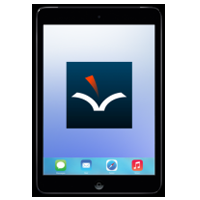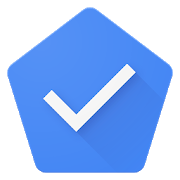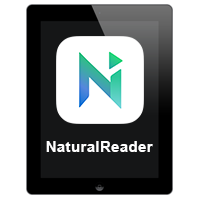What is Assistive Technology for reading support? Assistive technology that provides reading support includes devices and software that help an individual read text (books, textbooks, websites) in a variety of ways beyond reading traditional text. AT for reading includes the use of hardware such as laptops, tablets, or dedicated devices for e-text or audio text. AT for reading also includes software that will convert printed text to digital text and read it aloud with a synthesized voice. AT reading support software is sometimes called literacy suite software. Text-to-speech is the term to describe software that reads aloud digital text.
 When do I need to use AT for reading? Depending on the needs of the individual, AT for reading support may be used in any environment where the individual needs to read traditional printed text such as a book, textbook, newspaper, community event program, or website content. Other individuals may switch between reading traditional text to using AT to play or read the text aloud. Alternating between these methods is useful when the individual may need to take a break from reading traditionally printed text.
When do I need to use AT for reading? Depending on the needs of the individual, AT for reading support may be used in any environment where the individual needs to read traditional printed text such as a book, textbook, newspaper, community event program, or website content. Other individuals may switch between reading traditional text to using AT to play or read the text aloud. Alternating between these methods is useful when the individual may need to take a break from reading traditionally printed text.
Who needs AT to help with reading? Individuals may struggle with reading traditionally printed materials due to a physical limitation, visual impairment, or cognitive need such as dyslexia. A physical disability may prevent a person from holding a book or turning the pages. For individuals who are blind or have low vision, traditional printed text is difficult to read. Individuals may have an identified disability such as dyslexia and cannot decode text or comprehend the sentence structure. Still others may be “unidentified” struggling readers. Individuals with language learning disabilities often struggle with making meaningful connections with printed text, as do individuals who are English Language Learners (ELLs) and individuals with cognitive disabilities.
Why? Having a print disability is a fairly common need, but using assistive technology to interact with printed text opens a whole new world to many struggling readers.
Resources for Reading (part of Learning, Cognition & Development)
AT3 Center Videos on Reading
EasterSeals Crossroads -
INDATAProject TechTip Videos
Easter Seals Crossroads has been providing assistive technology solutions in Indiana since 1979. In 2007, Easter Seals Crossroads partnered with the State of Indiana, Bureau of Rehabilitative Services to establish the Indiana Assistive Technology Act (INDATA) Project. The INDATA Project offers excellent videos and Podcasts that provide timely updates on new assistive technology.
Here's INDATA's YouTube video playlist for Tech Tips for Learning Disabilities and Dyslexia (which includes many videos on Reading topics).
INDATA also offers three Podcasts that you can listen to, or subscribe to, on this page. At the top right of any of these pages you can search for a specific disability category.
The AT3Center.net wishes to thank the INDATA Project for their expertise and excellence in advancing access and awareness of assistive technology.
Information on this page addresses Assistive Technology for people with reading disabilities in...
EDUCATION | EMPLOYMENT | COMMUNITY LIVING
(click the titles above to jump to the content area)
EDUCATION

Talking Points for Reading Assistive Technology in Education
Many students struggle with reading. One estimate is that about 10 million children have difficulties learning to read. Individuals with reading issues often mix up the letters and words they're trying to identify. The good news is that 90 to 95 percent of children with reading difficulties can overcome their difficulties with remediation and AT support.
Children aged 0-3 may have pre-literacy supports written in to their child's Individualized Family Service Plan (IFSP). Students transitioning into the community or employment settings upon high school graduation will need to transition with the assistive technology they are used to. The Individualized Plan for Employment (IPE) is developed through collaboration with the Department of Rehabilitation Services (DRS) using a Vocational Rehabilitation (VR) Counselor. Please see the Employment section below.
For children transitioning into the public school at age 3 - To ensure successful AT transitions for children turning 3 years old, it is important for any AT the child is currently using or may need to use in school, whether written into the child's Individual Family Service Plan (IFSP) or not, be incorporated into the child's Individualized Education Program (IEP). You'll find this information in the Community section below.
For students transitioning into the community or employment settings upon high school graduation - To ensure successful AT transitions for students aging out of school services, it is important for any AT the student is currently using or may need to pursue employment outcomes, whether written into the child's Individualized Education Program (IEP) or not, be incorporated into the student's Individualized Plan for Employment (IPE). IPEs are developed through collaboration with the state vocational rehabilitation agency using a Vocational Rehabilitation (VR) Counselor. You'll find this information in the Employment section below.
Situations where a child might need assistive technology for reading:
School Environment
- K-12 classes
- Small group activities that include reading.
Socialization
- Friendship communication via texting or social media
Family / Home Environment
- Homework
- Studying for quizzes or tests
- Leisure reading
Community
- Library
- Restaurants
- Events
Commonly Asked Questions for a Student Who Struggles with Reading
Please listen to this section and/or download a transcript here: TXT format
Solutions for Students Who Need Reading Support
(click to open the accordions below)
Talking Points for Reading Assistive Technology in Employment
The category of Employment encompasses people of working-age who are currently employed or who are seeking employment. The following talking points may be applicable to individuals with disabilities as well as employers.
Individuals who need support for reading may have dyslexia or another specific type of learning disability. People with learning disabilities may have limitations that make it difficult to read text. It can be difficult to visually discern letters and numbers. The characters may appear jumbled or reversed. Entire words or strings of letters may be unrecognizable. Reading deficits can affect reading text from a print copy or text from a computer screen. Deficits in visual, auditory, or motor processing can interfere with reading and reading comprehension. Note: Reading supports for individuals with low vision and blindness are addressed in the Vision AT Discovery webpage.
For students transitioning into the community or employment settings upon high school graduation - To ensure successful AT transitions for students aging out of school services, it is important for any AT the student is currently using to be incorporated into the student's Individualized Plan for Employment (IPE). IPEs are developed through collaboration with the Department of Rehabilitation Services (DRS) using a Vocational Rehabilitation (VR) Counselor.
Situations where an individual might need assistive technology for reading
Work Environment
- Interview process
- Meetings
- Trainings
- Daily tasks
Socialization
- Work lunches
- Social media
- Telecommunication
- Group and committee activities
Family / Home Environment
- Homework
- Video games
- Social media
- Reading
Community
- Library
Commonly Asked Questions for an Individual Who Has Reading Impairments
Q - What types of learning disabilities are there?
A - Learning disabilities (LD), sometimes referred to as “specific learning disorders,” are life-long, but adults who have LD can experience great success in all aspects of life when using their strengths together with the strategies, accommodations and technology that are most appropriate and effective for their individual needs.
Learning disabilities can be divided into three broad categories: developmental speech and language disorders, academic skills disorders, and other (such as coordination disorders). Learning disabilities are disorders that affect the ability to understand or use spoken or written language, do mathematical calculations, coordinate movements, or direct attention. Learning disabilities are a lifelong condition; they are not outgrown or cured, though many people develop coping techniques through special education, tutoring, medication, therapy, personal development, or adaptation of learning skills. Approximately 15 million children, adolescents, and adults have learning disabilities in the United States.
Q - I am a qualified person with a disability under the ADA and need AT to do my job. May I ask my employer to provide it?
A - Individuals with disabilities may ask for an accommodation at any time even for an interview.
A - What types of AT can I ask for?
Q - Assistive technology that is needed to do the essential functions of the job can be requested.
Case Studies of Individuals with Reading Support Needs in Employment
(click to open the accordions below)
| Video/Podcast Resources: |
|---|
| Free to Low Cost Assistive Technology Solutions |
| Asking for Accommodations on the Job |
Talking Points for Assistive Technology for Reading in Community Living
The category of Community Living encompasses individuals of varying age groups including infants and toddlers under the age of 3, individuals who were born with or have acquired an injury and are otherwise participating in community activities (not as students or employees), and individuals who are retired and need AT support to live independently and participate in the community. The following talking points are applicable to individuals with disabilities as well as family members and others providing support and care to these individuals with disabilities.
Sometimes an individual may already have the necessary assistive technology to live independently at home and participate in the community. When that is the case, the following ideas will show other considerations regarding accessibility and accommodations. However, when the person requires additional tools to participate, the Human Activity Assistive Technology (HAAT) model will be used to show how an individual might best match up with a piece of AT to be used in the community and home.
For those children transitioning into the public school at age 3 - To ensure successful AT transitions for children turning 3 years old, it is important for any AT the child is currently using or may need to use in school, whether written into the child's Individual Family Service Plan (IFSP) or not, be incorporated into the child's Individualized Education Program (IEP).
Link to Education section
Situations where an individual might need assistive technology for Reading
Socialization
- Dining out and reading the menu
- Telecommunications and texting
Community
- Doctor's office visits
- Hospital
- Church
- Shopping
- Volunteer activities
- Entertainment
- Sports
- Library
- Utilities
Family/Home Environment
- Talking on the phone
- Paying bills
- TV
- Doing chores
- Games
- Computer tasks/games
- Newspapers and books
Commonly Asked Questions for a Person Who Needs Reading Support
Q - What types of learning disabilities are there?
A - Learning disabilities (LD) sometimes referred to as “specific learning disorders,” are life-long, but adults who have LD can experience great success in all aspects of life when using their strengths together with the strategies, accommodations and technology that are most appropriate and effective for their individual needs.
Learning disabilities can be divided into three broad categories: developmental speech and language disorders, academic skills disorders, and other (such as coordination disorders). Learning disabilities are disorders that affect the ability to understand or use spoken or written language, do mathematical calculations, coordinate movements, or direct attention. Learning disabilities are a lifelong condition; they are not outgrown or cured, though many people develop coping techniques through special education, tutoring, medication, therapy, personal development, or adaptation of learning skills. Approximately 15 million children, adolescents, and adults have learning disabilities in the United States.
Q - What is Assistive Technology?
A - AT is anything that helps a person do a task easier, better, or more efficiently, that otherwise would be difficult or impossible to do.
Solutions for Individuals Who Need Reading Support
(click to open the accordions below)




 Slantboard for book stabilizer or DIY with 3 ring binder or lapdesk.
Slantboard for book stabilizer or DIY with 3 ring binder or lapdesk. This student just started Pre-K and parents report child has difficulty holding books and turning pages at home. She enjoys being read to, but wants to also hold the book and flip pages like her big brother and classmates do. The student will also need to begin to recognize letters and phonics. Possible Recommendations: In this case study, the student is very young, but shows enthusiasm for learning to read and wants to sit and flip through books but often drops the book or can’t flip through each page one at a time. Students, parents, and teacher have been reading to the student, which she enjoys but appears to become frustrated when she can’t also hold the book and “read”. Books are adapted with large plastic paper clips to separate and “fluff” pages. This works well for her. Another book was adapted with small binder clips on each page. The student also uses a small tablet to hear and see digital books through apps that read aloud while highlighting the text as it is spoken.
This student just started Pre-K and parents report child has difficulty holding books and turning pages at home. She enjoys being read to, but wants to also hold the book and flip pages like her big brother and classmates do. The student will also need to begin to recognize letters and phonics. Possible Recommendations: In this case study, the student is very young, but shows enthusiasm for learning to read and wants to sit and flip through books but often drops the book or can’t flip through each page one at a time. Students, parents, and teacher have been reading to the student, which she enjoys but appears to become frustrated when she can’t also hold the book and “read”. Books are adapted with large plastic paper clips to separate and “fluff” pages. This works well for her. Another book was adapted with small binder clips on each page. The student also uses a small tablet to hear and see digital books through apps that read aloud while highlighting the text as it is spoken.





 This high school student has autism and is not reading on grade level. He struggles with reading printed text and appears to lose track of where he is on the page. He also indicated he is bored. The educator tested his ability to listen and read text-to-speech or accessible books. After several days of trying this in the classroom and answering questions about the book, he indicated that he enjoyed using a device to read back to him.
This high school student has autism and is not reading on grade level. He struggles with reading printed text and appears to lose track of where he is on the page. He also indicated he is bored. The educator tested his ability to listen and read text-to-speech or accessible books. After several days of trying this in the classroom and answering questions about the book, he indicated that he enjoyed using a device to read back to him.















 It is never too early to teach print and book awareness, so she would touch and say the name of objects in the home and community and encourage him to do the same. She would take him often to the library or to an exploratory museum with hands-on activities. Sarah learned that she should talk about the top and bottom of a book as well as the front/back, and open/close during book handling. Other ideas Sarah used include allowing her son to scribble, stamp, finger paint, use stickers or alternative pencils; have access to big books on the floor any time during the day. She also added interesting textures and post it notes to make the books into peek-a-boo books. He would feel the textures she added and could learn to lift the post it note to see what was beneath. Sarah also labeled objects at home, matched pictures to words, and introduced him to a variety of forms of print and text such as digital text or 3D letters. She also sat with him on her lap to touch the keyboard and see pictures and words on the computer screen. He would also use her iPhone to view books and apps for his age group.
It is never too early to teach print and book awareness, so she would touch and say the name of objects in the home and community and encourage him to do the same. She would take him often to the library or to an exploratory museum with hands-on activities. Sarah learned that she should talk about the top and bottom of a book as well as the front/back, and open/close during book handling. Other ideas Sarah used include allowing her son to scribble, stamp, finger paint, use stickers or alternative pencils; have access to big books on the floor any time during the day. She also added interesting textures and post it notes to make the books into peek-a-boo books. He would feel the textures she added and could learn to lift the post it note to see what was beneath. Sarah also labeled objects at home, matched pictures to words, and introduced him to a variety of forms of print and text such as digital text or 3D letters. She also sat with him on her lap to touch the keyboard and see pictures and words on the computer screen. He would also use her iPhone to view books and apps for his age group.


 He explained that he had always read at a slow pace and had tried to re-read many times in his lifetime until he just gave up. Charles’ new friend recognized some of Charles’ reading characteristics as indicators for dyslexia. She talked to Charles about using digital text (documents and books) which can be read aloud by technologies that offer text to speech software or even human speech such as books on CD or MP3 from Audible. She noticed he uses a smartphone with a touch screen and has a computer at home. She describes how he can listen to books and newspapers through various digital files and devices. See the attached HAAT Model form to see how to match this person with needed AT.
He explained that he had always read at a slow pace and had tried to re-read many times in his lifetime until he just gave up. Charles’ new friend recognized some of Charles’ reading characteristics as indicators for dyslexia. She talked to Charles about using digital text (documents and books) which can be read aloud by technologies that offer text to speech software or even human speech such as books on CD or MP3 from Audible. She noticed he uses a smartphone with a touch screen and has a computer at home. She describes how he can listen to books and newspapers through various digital files and devices. See the attached HAAT Model form to see how to match this person with needed AT. Anne recently talked to her manager, Robin, who described how she had been diagnosed with a reading and print disability. She explained the various technologies she used to read digital books, which allowed her to hear the text at the same time she could see the words. Homework, work handouts, textbooks, leisure books, menus, and emails, as digital text, were flexible so that text-to-speech (TTS) software on computers, tablets, and phones could read it aloud. Her ability to study, read work manuals, pay bills, and read for fun were all so much easier and took far less time. She demonstrated to Anne how to take a picture of a menu or document with her phone and use the ClaroPDF app to read the text aloud. Anne then began to use the Claro PDF app and could take pictures of her daughter’s books. With an earbud in one ear, she could repeat what she heard and read the book to her daughter. Anne also discovered on her own the many options for TTS and often saved whole documents and books into digital text and downloaded it to her phone so she could listen in the car or at home. She realized that she could very likely succeed in a post-secondary school and earn a degree to allow her to find a higher paying job.
Anne recently talked to her manager, Robin, who described how she had been diagnosed with a reading and print disability. She explained the various technologies she used to read digital books, which allowed her to hear the text at the same time she could see the words. Homework, work handouts, textbooks, leisure books, menus, and emails, as digital text, were flexible so that text-to-speech (TTS) software on computers, tablets, and phones could read it aloud. Her ability to study, read work manuals, pay bills, and read for fun were all so much easier and took far less time. She demonstrated to Anne how to take a picture of a menu or document with her phone and use the ClaroPDF app to read the text aloud. Anne then began to use the Claro PDF app and could take pictures of her daughter’s books. With an earbud in one ear, she could repeat what she heard and read the book to her daughter. Anne also discovered on her own the many options for TTS and often saved whole documents and books into digital text and downloaded it to her phone so she could listen in the car or at home. She realized that she could very likely succeed in a post-secondary school and earn a degree to allow her to find a higher paying job.

